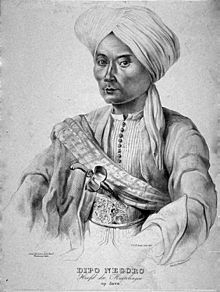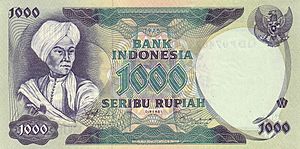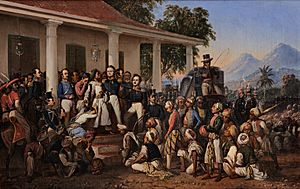Diponegoro facts for kids
Quick facts for kids Diponegoro |
|
|---|---|
| Sultan Abdul Hamid Herucakra Amirul Mukminin Sayyidin Panatagama Kalifatullah ing Tanah Jawa | |

Portrait of Prince Diponegoro, 1835
|
|
| Born | 11 November 1785 Yogyakarta Sultanate |
| Died | 8 January 1855 (aged 69) Oedjoeng Pandang, Dutch East Indies |
| Spouse |
|
| Issue | 17 sons, 5 daughters |
| House | Mataram |
| Father | Hamengkubuwana III |
| Mother | Mangkarawati |
| Religion | Islam |
Prince Diponegoro (Javanese: ꦢꦶꦥꦤꦼꦒꦫ; born Bendara Raden Mas Mustahar, ꦧꦼꦤ꧀ꦢꦫꦫꦢꦺꦤ꧀ꦩꦱ꧀ꦩꦸꦱ꧀ꦠꦲꦂ; later Bendara Raden Mas Antawirya ꦧꦼꦤ꧀ꦢꦫꦫꦢꦺꦤ꧀ꦩꦱ꧀ꦲꦤ꧀ꦠꦮꦶꦂꦪ; 11 November 1785 – 8 January 1855) was a brave Javanese prince. He stood up against the colonial rule of the Dutch in Java.
Diponegoro was the oldest son of Sultan Hamengkubuwono III of Yogyakarta. He played a very important part in the Java War, which lasted from 1825 to 1830. After a long fight, he was captured and sent away to Makassar, where he died at 69 years old.
His five-year struggle against the Dutch is still celebrated in Indonesia. He became a big inspiration for people fighting for Indonesia's freedom. Today, Diponegoro is known as a national hero in Indonesia.
Contents
Early Life of Prince Diponegoro
Diponegoro was born on November 11, 1785, in Yogyakarta. He was the first son of Sultan Hamengkubuwono III. When he was young, many big changes happened in Java. The Dutch East India Company (VOC) lost its power. Then, the British took over Java in 1811, but later the Dutch came back.
During the British invasion, Diponegoro's father became Sultan. Diponegoro even helped the British. He was offered the title of Sultan, but he said no. This was probably because his father was still ruling.
In 1814, his father died. Diponegoro was not chosen to be the next Sultan. Instead, his younger half-brother, Hamengkubuwono IV, became Sultan. The Dutch supported this choice, even though Diponegoro's father wanted him to be the next ruler.
Diponegoro was a very religious Muslim. He was worried because his half-brother's court was not as religious. He also didn't like that the court was too friendly with the Dutch.
In 1821, a terrible famine and sickness spread across Java. Then, in 1822, Sultan Hamengkubuwono IV died in a mysterious way. He left behind a very young son as his heir. When this one-year-old boy became Sultan Hamengkubuwono V, there was a fight over who would guide him. Diponegoro was again left out, even though he thought he should have been the next Sultan. All these problems, along with natural disasters, finally led to a big rebellion.
Fighting the Dutch
The Dutch colonial government was becoming very unpopular. Local farmers were upset because taxes were too high and their crops failed. Javanese nobles were angry because the Dutch took away their right to rent out land.
Many people believed Diponegoro was the Ratu Adil. This means "the just ruler" who was predicted to come and save the people. A volcano, Mount Merapi, erupted in 1822, and a sickness spread in 1824. These events made people think a big change was coming. This led to many people supporting Diponegoro.
Before the war started, Dutch officials didn't do much, even though they heard rumors of a rebellion. Stories spread among the people. Some said Diponegoro had visions or even met a mythical queen, Nyai Roro Kidul.
At the start of the war, the Dutch suffered big losses. They didn't have a clear plan against Diponegoro's guerrilla warfare. Diponegoro's forces set up ambushes and stopped food from reaching the Dutch troops.
The Dutch finally decided to stop the rebellion. They sent more soldiers and a general named Hendrik Merkus de Kock. General De Kock used a new plan. He built strong, fortified camps (called benteng) and used mobile groups of soldiers. The camps helped control key areas. The mobile groups tried to find and fight Diponegoro's rebels.
By 1829, Diponegoro started losing the advantage. He was forced to defend himself. Many of his soldiers and leaders were defeated or left his side.
Capture and Exile
By 1830, Diponegoro's army was almost completely defeated. Talks began between him and the Dutch. Diponegoro wanted his own free state and to be the Muslim leader for all of Java.
In March 1830, he was invited to talk under a flag of truce. He agreed and met in the town of Magelang. However, on March 28, he was taken prisoner, despite the truce. General De Kock said he had warned Javanese nobles that Diponegoro needed to lower his demands.
Diponegoro and the Dutch saw his arrest very differently. Diponegoro felt it was a betrayal because of the truce. The Dutch said he had surrendered. Paintings of the event also show different views. A Javanese artist, Raden Saleh, showed Diponegoro as a brave victim. A Dutch painter, Nicolaas Pieneman, showed him as a man who had given up.
Right after his arrest, Diponegoro was taken to Semarang and then to Batavia (now Jakarta). He was held in a basement that is now part of the Jakarta History Museum. In 1830, he was sent by ship to Manado, on the island of Sulawesi.
After several years in Manado, he was moved to Makassar in July 1833. He was kept inside Fort Rotterdam. The Dutch thought the first prison was not strong enough to hold him. Even though he was a prisoner, his wife, Ratnaningsih, and some of his followers went with him into exile. Important visitors came to see him, including the 16-year-old Dutch Prince Henry in 1837.
During his exile, Diponegoro also wrote books about Javanese history. He wrote his own life story, called Babad Diponegoro. His health got worse as he grew older. He died on January 8, 1855, at the age of 69.
Before he died, Diponegoro asked to be buried in a neighborhood called Kampung Melayu. The Dutch gave land for his graveyard. Today, his tomb is visited by many people, including military officers and politicians. His wife and followers were also buried there later.
Legacy and Impact

Diponegoro's family line still exists today. The Sultans of Yogyakarta are still governors of the Special Region of Yogyakarta. In 1969, a large monument called Sasana Wiratama was built in Yogyakarta. It stands where Diponegoro's palace was believed to be.
In 1973, under President Suharto, Diponegoro was officially named a National Hero of Indonesia.
Many things in Indonesia are named after him. The Indonesian Army has a regional command called Kodam IV/Diponegoro. The Indonesian Navy has two ships named after him: KRI Diponegoro (306) and Invalid Optional Parameter. Diponegoro University in Semarang is also named after him, along with many main roads in Indonesian cities. Diponegoro's story is also told in Javanese poems, wayang (shadow puppet plays), and other performances. He even wrote about himself in Babad Diponegoro.
The spirit of resistance in Java rose again during the Indonesian National Revolution. This was when Indonesia fought for and gained its independence from the Netherlands. Early Islamic political groups in Indonesia saw Diponegoro's fight as part of Indonesia's national struggle. They believed Islam played a big role in forming the country.
In March 2020, the King of the Netherlands, Willem-Alexander, visited Indonesia. He gave the kris (a special dagger) of Prince Diponegoro to Indonesia. President Joko Widodo received it. This kris was thought to be lost for a long time. It was found and identified by a Dutch museum. The kris is very important. It is a symbol of Indonesian strength and the nation's fight for freedom. This special dagger, which used to be in the Dutch state collection, is now part of the Indonesian National Museum. However, some experts are not sure if this kris is the original one that belonged to Diponegoro.
See also
 In Spanish: Diponegoro para niños
In Spanish: Diponegoro para niños




